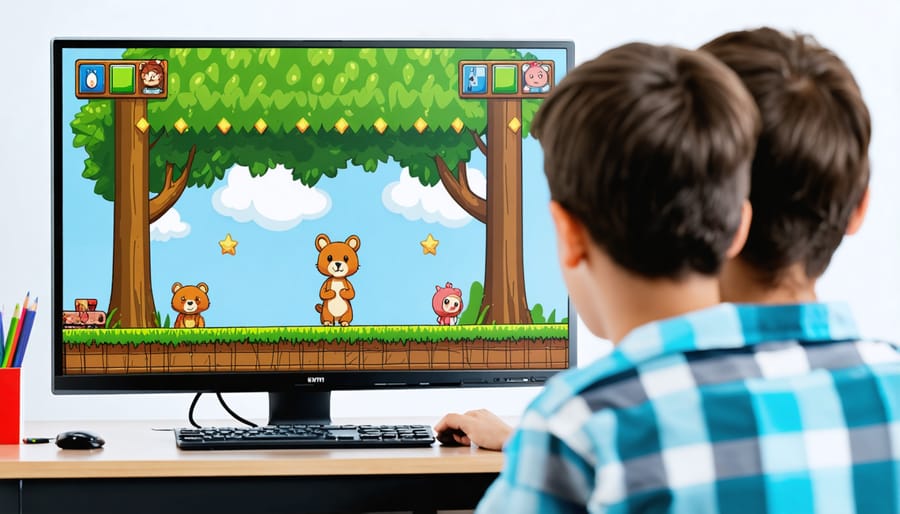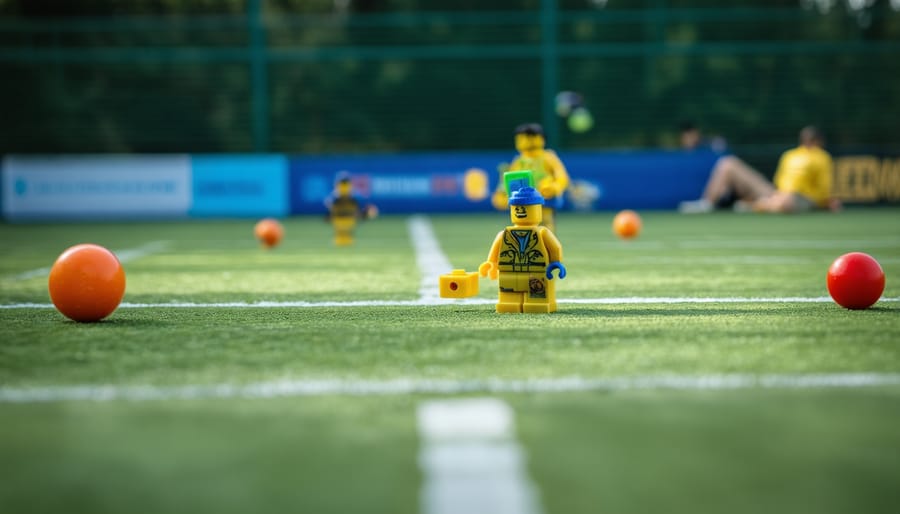Your Students Are Already Playing These Games – Here’s How to Make Them Educational
Your students are searching for games during class time, and you’re stuck between wanting to engage them and maintaining network security. Here’s the reality: those “unblocked games” websites students hunt for are often inappropriate, distracting, and full of content you’d never approve for your classroom. But their desire to play games reveals something important—they’re craving interactive, engaging learning experiences.
Transform this challenge into your biggest teaching advantage. Educational games don’t need to come from sketchy websites that IT departments block for good reason. The most effective game-based learning tools are already sitting in your Microsoft Office suite, completely unblocked and ready to customize for any lesson. PowerPoint game templates let you create quiz shows, escape rooms, and interactive challenges that align perfectly with your curriculum while giving you complete control over content, difficulty, and classroom management.
Stop fighting against games and start building with them. When you design your own educational games, you’re not just keeping students on-task—you’re creating memorable learning moments that stick. Your IT department will thank you, your students will stay engaged, and you’ll finally have classroom games that actually teach what you need them to learn.
Why Students Search for Unblocked Games (And What It Means for You)
Let’s be honest—you’ve probably noticed students trying to access gaming sites during free time, only to hit that dreaded “blocked by administrator” message. But here’s the thing: instead of seeing this as a discipline issue, what if we viewed it as a golden opportunity?
When students search for unblocked games, they’re really telling us something important. They’re craving engaging, interactive experiences that traditional worksheets just can’t provide. They want fun while they learn, and they’re motivated enough to seek it out on their own. That’s actually pretty amazing when you think about it!
The reality is that students need mental breaks and enjoy friendly competition. Gaming isn’t inherently bad—it’s about channeling that enthusiasm toward productive learning. When students are engaged and having fun, retention skyrockets. The challenge isn’t stopping them from wanting to play games; it’s giving them the right games to play.
This is where you come in with a game-changing solution. Rather than constantly monitoring which sites are blocked or worrying about inappropriate content, you can take control by bringing educational games directly into your classroom environment. Think alternatives to blocked games that you design yourself, customize for your curriculum, and launch without any technical hassles.
The best part? These tools work on your school’s existing network because they’re not external gaming sites at all. You’re essentially transforming that student desire for interactive fun into curriculum-aligned learning experiences. It’s a win-win: students get the engagement they crave, and you get a powerful teaching tool that reinforces your lessons while keeping everyone on task.
What Makes a Game ‘Educational’ Without Killing the Fun
The magic happens when students are so engaged they forget they’re learning! But what’s the secret ingredient that transforms a game from just another digital distraction into a powerful educational tool?
Think about what gets your students excited during game time. Competition often tops the list. When students can track their progress, compete with classmates, or race against the clock, their motivation skyrockets. This healthy competition naturally encourages them to practice skills repeatedly without feeling like drill work.
Immediate feedback is another game-changer. In traditional worksheets, students might wait hours or even days to know if they got something right. Games provide instant responses, letting learners correct mistakes in real-time and understand concepts faster. This quick feedback loop keeps frustration low and engagement high.
Peer interaction transforms solitary learning into a social experience. When games allow students to work in teams, compete head-to-head, or simply share their achievements with classmates, you’re tapping into their natural desire to connect. This social element makes learning memorable and fun.
Content reinforcement through repetition is where games really shine. Students willingly practice the same math facts, vocabulary words, or science concepts multiple times because the game format makes it enjoyable. They’re getting that crucial repetitive practice without the monotony of traditional methods.
The key is customization. You know your students best, so the most effective educational games let you adjust difficulty levels, choose specific skills to target, and modify content to match your curriculum. When games are flexible enough to meet your classroom’s unique needs, they become true teaching partners rather than one-size-fits-all distractions.
Here’s the exciting part: you don’t need fancy software or complicated platforms to achieve this sweet spot. Simple, teacher-created games often work better than expensive programs because you’re in complete control of the content, pacing, and rules. Your creativity combined with student enthusiasm creates the perfect educational experience.

PowerPoint Game Templates: Your Secret Weapon
Built-In Features That Save You Time
The best part? These PowerPoint game templates come ready to play right out of the box. You won’t need to spend hours building basic features from scratch. Most templates include built-in scoreboards that automatically track points, making competition exciting and fair for your students. Sound effects add that game-show atmosphere kids love, whether it’s a celebratory chime for correct answers or a friendly buzz for tries that need another attempt.
Many templates feature countdown timers that keep the pace moving and add just the right amount of excitement without overwhelming learners. You’ll also find pre-designed answer buttons, colorful animations, and question slides already formatted and waiting for your content. Simply plug in your vocabulary words, math problems, or science facts, and you’re ready to launch.
The beauty of these built-in features is that they’re completely customizable too. Keep the timer at 30 seconds or adjust it to 60. Change the point values to match your classroom reward system. Mute the sounds if your class works better in a quieter environment. These thoughtful touches mean you get instant usability with the flexibility to make each game perfectly suited to your teaching style and your students’ needs.

Match Any Subject, Any Grade Level
Here’s what makes these game templates truly special – they work for absolutely any subject and any grade level you teach. That math review game you created? With a few quick edits, it becomes a science vocabulary challenge or a history trivia competition. The secret is customization.
Unlike fixed educational games that only cover specific topics, editable game templates let you insert your own questions, vocabulary words, or problems directly into the slides. Teaching fractions to third graders? Perfect. Need to review Spanish verbs with high schoolers? Same template works beautifully. Preparing kindergarteners for sight word recognition? You got it.
The best part is how simple the process is. You’re basically just typing your content into pre-designed slides. Change the questions, swap out the answers, and maybe adjust the difficulty level. That’s it. No special training required, and you don’t need to learn complicated software.
This flexibility means you can build a small library of favorite game templates and reuse them throughout the year across different units. One template might serve you in September for back-to-school content, then again in December for holiday-themed review, and once more in May for end-of-year assessments. You’re investing time once and getting endless returns.
Teachers love this because it eliminates the frustration of finding that perfect game only to discover it doesn’t match your curriculum. You control the content completely, ensuring every game aligns perfectly with what your students actually need to learn.
Popular Game Formats That Students Actually Enjoy
Students light up when they encounter games that feel genuinely fun rather than thinly disguised worksheets. The good news? Certain game formats consistently win over even the toughest crowds while delivering solid learning outcomes.
Jeopardy-style games remain classroom favorites because they tap into that competitive game show energy students recognize from TV. The familiar format requires zero explanation, and the category-based structure lets you seamlessly organize content by topic, skill level, or review area. Students love the thrill of choosing their own questions and wagering points, which gives them agency in their learning experience.
Trivia competitions work wonders for quick reviews and formative assessments. These fast-paced games keep energy high and attention focused, especially when you add buzzers or timers. The beauty lies in their flexibility—you can run them as individual challenges, partner activities, or whole-class competitions. Students genuinely enjoy testing their knowledge in low-stakes environments where mistakes become learning opportunities rather than grade penalties.
Team-based game formats generate incredible engagement because they combine academic content with social interaction. When students collaborate in teams, they naturally discuss concepts, debate answers, and teach each other. This peer-to-peer learning often sticks better than traditional instruction. Team challenges also reduce individual performance anxiety while building classroom community.
Board game adaptations bring nostalgic appeal that resonates across age groups. Whether you’re creating a Monopoly-style journey through historical events or a Candy Land path through math problems, these familiar frameworks make content approachable. Students appreciate the strategic elements and the clear visual progression toward winning.
The customization factor matters tremendously here. When you tailor these formats to your specific curriculum and student interests, engagement skyrockets. Adding student names, inside jokes, or current events makes educational games feel personalized rather than generic, transforming review time into something students actually request.

Quick Setup Tips to Get Playing Fast
Getting your educational games up and running doesn’t require a computer science degree or hours of setup time. In fact, you can have students playing and learning in just a few minutes with these straightforward tips.
Start by downloading your chosen PowerPoint game template to your computer. Most templates work seamlessly with PowerPoint 2010 and newer versions, though older versions usually handle them fine too. If you’re working with Google Slides, simply upload the file and let it convert automatically. The beauty of these games is that they’re already installed on most school computers, so there’s zero software download hassle.
Before class begins, take five minutes to customize the game content. Open the template and click through a few slides to see where questions or content appear. Most templates have clearly marked text boxes where you can type in your own questions, vocabulary words, or math problems. Change the difficulty level by adjusting the questions to match your students’ current abilities. This personalization makes the game feel fresh and relevant to your exact lesson plan.
Test the game quickly by clicking through it in presentation mode. Make sure you understand how students advance through levels or earn points. This quick run-through helps you explain the rules confidently and troubleshoot any hiccups before students dive in.
For classroom logistics, decide whether students will play individually, in pairs, or as teams. Have a backup plan ready, like projecting the game on your smartboard if student devices act up. Keep a timer handy to maintain energy and ensure everyone gets equal playing time. Most importantly, have fun with it! Your enthusiasm makes the game even more engaging for students.
Beyond Review: Creative Ways to Use Educational Games
Educational games aren’t just for review sessions! Think bigger and get creative with how you integrate these tools throughout your school day.
Start your morning with quick icebreaker games that help students connect. A collaborative quiz game can reveal fun facts about classmates while warming up their brains for learning. Use team-based games to build cooperation skills during advisory periods or before group projects.
Reward days become special without losing learning value. Let students choose their favorite educational game as a Friday treat or celebrate meeting classroom goals with a game tournament. You’re still reinforcing concepts while giving them something to look forward to.
For those early finishers who always need something productive, keep a rotation of games bookmarked and ready. This beats busywork and keeps advanced learners engaged without disrupting others. Customize difficulty levels to match each student’s needs.
Need engaging transitions between lessons? A five-minute game can reset energy levels and refocus attention. Moving from reading to math? Play a quick number game. Shifting to science? Try a vocabulary challenge related to your next unit.
The beauty of unblocked educational games is their flexibility. You control when, how, and why they’re used. They’re not just test-prep tools but versatile classroom companions that make every moment count. Keep several favorites ready and watch how naturally they fit into your daily routine.
Here’s the exciting truth: your students’ love for games isn’t something to fight against—it’s an incredible opportunity waiting to be redirected! When kids are trying to access those blocked gaming sites, they’re showing you exactly what motivates them. The good news? Educational games can deliver that same excitement and engagement while keeping you firmly in control and perfectly aligned with your curriculum goals.
You don’t need to worry about inappropriate content, security risks, or students drifting off-task when you choose classroom-appropriate gaming alternatives. These tools are designed to work seamlessly within your school’s network, require no special permissions, and give you complete customization options to match your lesson plans. Your students get the fun, interactive experience they crave, and you get meaningful learning outcomes that truly matter.
So take that next step today! Transform those gaming impulses into powerful learning moments. Explore the educational game templates available to you, customize them for your classroom needs, and watch your students discover that learning can be just as thrilling as any game they were trying to sneak past the filters. You’ve got this!


